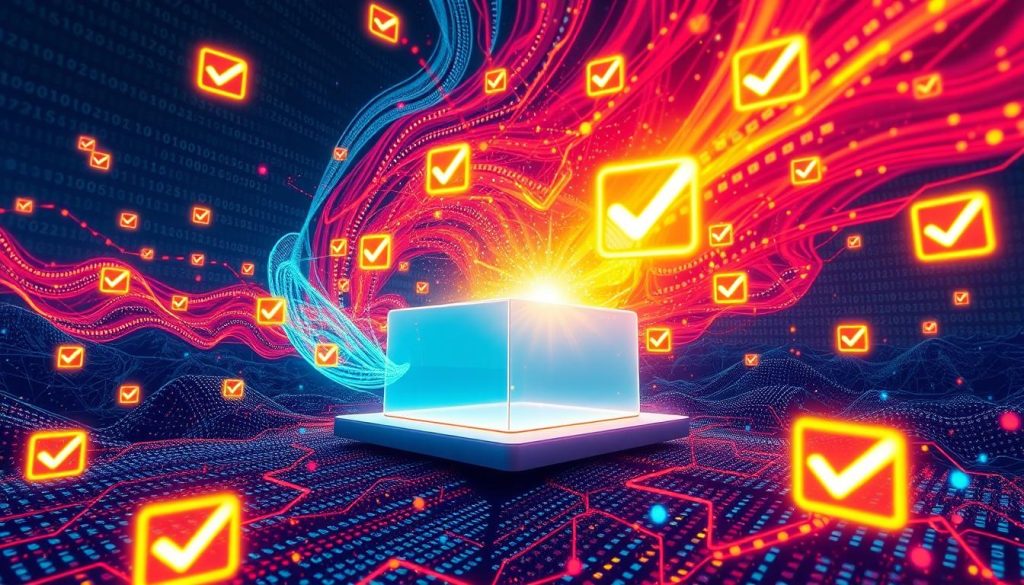Email marketing is still a key way for businesses to reach their audience. But, the success of your emails depends on the quality and delivery of your lists. This article talks about how list cleaning and verification are key. They help make sure your emails get to the right people, improve your marketing, and keep your reputation good.
Key Takeaways
- Maintaining a clean and up-to-date email list is essential for effective email marketing
- Email list hygiene helps improve deliverability and reduce bounce rates
- Regular list cleaning and verification ensures your emails reach the intended audience
- Implementing best practices like double opt-in can strengthen your email list management
- Validating email addresses and adhering to anti-spam regulations are crucial for email compliance
Email List Hygiene: The Foundation of Effective Email Marketing
Keeping your email list clean and updated is key to good email marketing. Email List Hygiene makes sure your messages get to the right people. This boosts the success of your email campaigns.
Understanding the Importance of Clean Email Lists
A clean email list is vital for good email deliverability and low email bounce rates. Regularly cleaning and checking your email contacts helps your list stay healthy. This leads to better engagement, higher open rates, and stronger connections with your subscribers.
The Consequences of Neglecting Email List Hygiene
Ignoring email list hygiene can hurt your email marketing a lot. Bad email addresses cause high bounce rates, damaging your reputation and making it hard to reach your subscribers. Also, poor email list management can make your emails seen as spam, hurting your deliverability.
| Metric | Importance | Consequence of Neglecting Email List Hygiene |
|---|---|---|
| Email Deliverability | Ensures your messages reach the intended recipients | Decreased deliverability, leading to lower engagement and impact |
| Email Bounce Rate | Indicates the health of your email list | High bounce rates can damage your sender reputation and email marketing performance |
Focus on email list hygiene and use best practices for email list management. This sets the stage for successful email marketing. It drives real engagement and results.
Email Deliverability: The Key to Reaching Your Audience
In the world of email marketing, email deliverability is key to success. It means your messages get to the right people’s inboxes, not lost or in spam. Keeping your email list clean and your email reputation strong is vital.
Many things affect email deliverability, like your mailing list’s quality and your domain’s reputation. Making sure your list is current and correct is a big step. Also, following industry rules and best practices helps your sender reputation. This makes it easier for your emails to get past spam filters and into the inbox.
By focusing on email list health and using effective strategies, you can boost your email marketing. This leads to more engagement, better conversion rates, and a stronger bond with your audience. These are all important for your business’s long-term success.
“Achieving high email deliverability is like unlocking the door to your audience’s attention. It’s a game-changer for any successful email marketing strategy.”
In the next parts, we’ll explore strategies and best practices. These will help you keep your email list healthy and ensure your messages reach your audience.
Email Bounce Rate: A Crucial Metric for List Cleaning
In the world of email marketing, the email bounce rate is key. It shows how healthy your Email List Hygiene and Email List Management are.
Understanding Different Types of Email Bounces
Email bounces fall into two main categories: hard bounces and soft bounces. Hard bounces happen when an email can’t be sent because the address is wrong. Soft bounces occur when an email can’t be sent right away, like if the inbox is full.
Strategies for Reducing Email Bounce Rates
Keeping your email bounce rate low is crucial. It makes sure your emails get to the right people. Here are some ways to do it:
- Regularly clean and verify your email list to find and remove bad addresses.
- Use a double opt-in process to make sure new subscribers are real.
- Keep an eye on your bounce rates and fix any problems fast.
- Find out why you’re getting bounces and change your email sending ways.
By being careful and active in managing your email bounce rates, you can improve your Email Deliverability. This means your messages will get to the right people, leading to better results for your Email Marketing.
Email List Management: Best Practices for Maintaining a Clean List
Effective email list management is key to a successful email marketing strategy. Keeping your subscriber list clean and active is vital. It helps you reach your audience, get emails delivered, and follow industry rules. We’ll look at the best ways to manage your email list, like cleaning it regularly, verifying emails, and using double opt-in.
Regular List Cleaning and Verification
Cleaning and verifying your email list often is crucial. It means getting rid of inactive or bad emails and keeping your list accurate. This helps improve your email deliverability and avoids spam filter problems.
Implementing Double Opt-In Strategies
Using double opt-in is a great way to build a good email list. It makes sure only people who really want to hear from you are on your list. Double opt-in helps keep your emails out of the spam folder and boosts engagement.
By following these best practices for email list management, you can keep your list clean and reliable. This will make your email marketing better and help you build trust with your audience.
List Cleaning and Verification: Ensure Hitting the Right Inboxes
In email marketing, a clean email list is key to success. List cleaning and verification help your messages land in the right inboxes. This boosts your email deliverability and reputation.
Keeping your email list clean is the base of good email marketing. By regularly cleaning and verifying your list, you remove bad addresses. This makes your list better and more relevant. It also helps avoid spam traps and bounce-backs that harm your email reputation.
Managing your list well is important. Using double opt-in, address checks, and automated cleaning helps keep your list healthy. This way, you can make sure your emails reach the right people.
“Effective email marketing starts with a clean, well-maintained email list. Investing in list cleaning and verification is essential to reaching your audience and driving meaningful engagement.”
The success of your email campaigns depends on your contact database’s quality. By focusing on list cleaning and verification, you can make your email marketing work better. You’ll send valuable content to the right people.
Email Validation: The Key to Accurate and Reliable Data
Email marketing thrives on a clean email list. At its core is email validation, ensuring your data is accurate and reliable. By picking the right validation service, you boost your Email List Hygiene, improve Email Deliverability, and fight Spam.
Types of Email Validation Techniques
There are many email validation methods. Each one helps remove bad email addresses from your list. Here are some common ones:
- Syntax Checks: These basic checks make sure an email address is correct, with a valid username and domain.
- Domain Verification: This method checks if the email domain exists and is valid, catching typos or fake domains.
- Mail Server Confirmation: This advanced method checks if the email address can receive emails by connecting to the recipient’s mail server.
- Honeypot Traps: Invisible email addresses are used to catch bot-generated or harvested email addresses.
Choosing the Right Email Validation Service
Choosing an email validation service is important. Look for one that is accurate, fast, and can handle big lists. Make sure it follows industry standards for Email Validation, Email Deliverability, and Spam Prevention.

Embracing email validation is key to a successful email marketing strategy. It helps you reach the right people, keeps your Email Reputation strong, and protects your business from bad list hygiene.
Spam Prevention: Protecting Your Email Reputation
In the world of email marketing, keeping a good reputation is key. Businesses face a big challenge: dealing with spam filters and blacklists. These can hurt your email’s success, affecting your email marketing campaigns.
Understanding Spam Filters and Blacklists
Spam filters protect inboxes from unwanted emails. They check the email’s content, sender, and how people interact with it. If an email is seen as spam, it might go to the junk folder or be blocked.
Blacklists list known spam sources. If your domain or IP is on these lists, your emails could be blocked. This greatly lowers your email deliverability.
Implementing Anti-Spam Best Practices
- Keep your email list clean by checking and removing old or bad addresses.
- Follow rules like the CAN-SPAM Act for commercial emails.
- Use double opt-in to make sure people really want to get your emails.
- Make your emails interesting and useful, avoiding spam words and tricks.
- Watch your email reputation and fix problems like high bounce rates or spam complaints.
Understanding spam filters and blacklists helps protect your email’s reputation. By following anti-spam best practices, your emails will reach more people. This makes your email marketing more effective.
| Tactic | Description | Impact on Email Reputation |
|---|---|---|
| Regular List Cleaning | Verifying and removing inactive or invalid email addresses from your mailing list | Improves email reputation by reducing bounce rates and spam complaints |
| Double Opt-In | Requiring subscribers to confirm their email address before adding them to your list | Enhances email reputation by ensuring only engaged subscribers are on your list |
| Relevant Content | Providing valuable, personalized content that resonates with your audience | Boosts email reputation by increasing engagement and reducing spam complaints |
Email Compliance: Navigating Legal and Regulatory Requirements
In the world of email marketing, following legal rules is key. We must understand and follow laws like the CAN-SPAM Act and GDPR. This ensures our emails are safe and respected.
Following these rules is more than just a task. It’s about earning trust from our readers and keeping our emails safe. By doing this, we avoid fines, damage to our reputation, and losing email contacts.
Key Compliance Considerations
- Obtaining explicit consent from subscribers before adding them to your email list
- Providing clear and easily accessible unsubscribe options in every email
- Accurately identifying the sender and including a valid physical mailing address in your emails
- Ensuring your email content does not contain misleading or deceptive information
- Monitoring and addressing any spam complaints or email bounces promptly
By focusing on email compliance, we protect our business and show we care about our readers’ privacy. This leads to a cleaner email list hygiene, better email deliverability, and a stronger email reputation. These are all key to great email marketing best practices.
“Compliance is not just a box to check, but a foundation for building trust with your subscribers and safeguarding your email marketing efforts.” – Email Marketing Expert
It might seem hard to follow email compliance rules, but with the right steps, you can do it. By focusing on compliance, you can make your email marketing better. This way, you can give value to your readers and keep your business safe.

Email Marketing Best Practices: Integrating List Cleaning and Verification
To make your email marketing better, you need a complete plan. This includes keeping your email list clean and verified. By following the best practices and always getting better, you can send more emails successfully. This helps keep your email reputation strong and your campaigns working well for a long time.
Aligning with Industry Standards
Keep up with the newest Email Marketing Best Practices from top groups. Learn about Email List Hygiene, Email Deliverability, and Email Reputation management. Using these tips helps you follow the law and keep your brand safe.
Continuous Improvement and Optimization
Check and improve your email list and campaigns often. Use Email Validation tools to find and remove bad email addresses. Look at your email bounce rates and spam complaints to find ways to get better.
By focusing on list cleaning and verification, you can make sure your emails get to the right places. This builds trust with your audience and makes your email marketing more effective.
“Maintaining a clean and verified email list is the foundation of successful email marketing. It’s the key to reaching your target audience and maintaining a strong email reputation.”
Conclusion: The Importance of List Cleaning and Verification
In the world of email marketing, keeping your email list clean is key to success. This article has shown how List Cleaning and Verification boost Email Deliverability and Email List Hygiene. It also protects your Email Reputation. By following best practices, your emails will reach the right people and engage them well.
The Email Marketing Best Practices we talked about are crucial. They include regular list cleaning, email validation, and following industry rules. These steps help protect your brand and build a loyal subscriber base. Keeping your email list in top shape helps you meet your marketing goals and share valuable content.
In short, List Cleaning and Verification are essential for good email marketing. They help you reach your full potential, improve your Email Reputation, and achieve business success. A clean and verified email list is powerful. It unlocks the full benefits of email marketing in today’s digital world.
FAQ
What is the importance of maintaining a clean email list?
A clean email list is key for good email marketing. It helps your emails get delivered, cuts down on bounce rates, and keeps your email reputation strong.
How does email deliverability impact the success of email marketing?
Email deliverability is vital for email marketing success. List quality, sender reputation, and following industry rules affect if your emails get to the right people. Keeping your email list clean is essential for better deliverability.
What are the different types of email bounces, and how can I reduce my bounce rate?
Email bounces are either hard or soft. Hard bounces mean the email address is wrong or doesn’t exist. Soft bounces are temporary delivery issues. To lower bounce rates, clean your list regularly, validate emails, and use double opt-in.
What are the best practices for managing and maintaining a clean email list?
Good list management includes cleaning and verifying your list often, using double opt-in, and following industry rules. Always work to improve and optimize your list and campaigns to keep your subscribers engaged.
How can email validation help ensure the accuracy and reliability of my email data?
Email validation is key for clean data. It checks your emails for syntax and real-time verification. This prevents spam and delivery problems, making your data reliable.
What are the key considerations for staying compliant with email marketing regulations?
Following legal rules like CAN-SPAM and GDPR is crucial for email marketing. This means having a clean list, getting the right consent, and being clear about your marketing.
How can I integrate list cleaning and verification into my overall email marketing strategy?
To include list cleaning in your strategy, follow industry standards, always improve and optimize, and use validation and cleaning tools. This approach keeps your email marketing healthy and successful over time.


